Rules of composition in street photography.
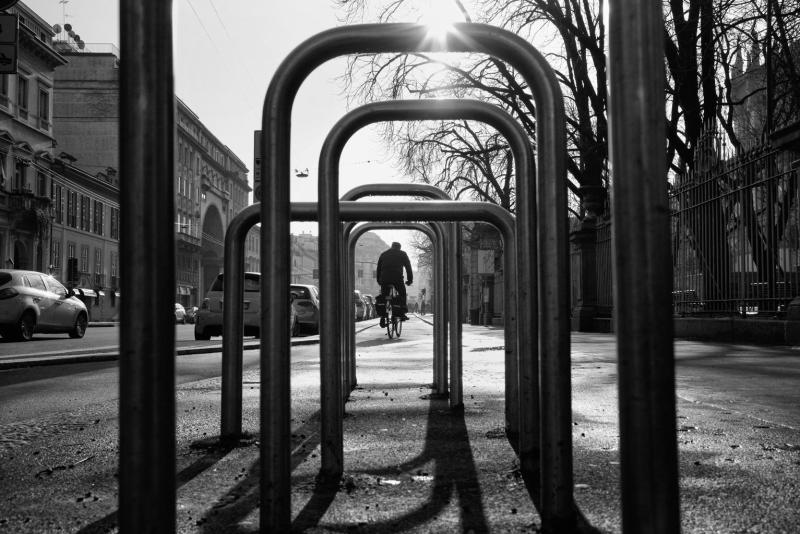
One of the main characteristics of Street photography is the urgency needed to capture that unique, unrepeatable moment which is the essence of this discipline.
This particularity could give the impression that there is no place for a carefully composed image in street photography. While there are styles in street photography that are all about capturing the moment, that doesn't mean there isn't an opportunity to approach this form of photography a little more carefully, and when I say "carefully" I mean trying something more than just harmony in the composition.
You have most likely noticed in my blog posts that I often insist that there are very few unbreakable rules in photography, well the same goes for street photography too. It's all a matter of taste and style. It's not better or worse to work on composition in these shots, it just depends on your style. More control just means taking a little longer to shoot, which will perhaps create a style that's just a tad more static.
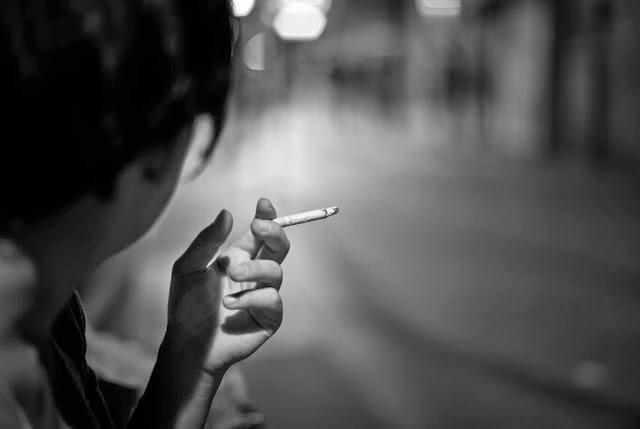
While this article explains the basic composition rules, it is done with a focus on landscape and cityscape photography. Although some of these rules are commonly applied in street photography in general, in some cases their application will vary a bit as in this field you will occasionally come across some peculiarities when composing the shot.
In short, in this article I will list what, in my opinion, are the basic rules of positive composition in street photography.
Pay attention to the background
This is a concept that we should always keep in mind in any genre of photography and it is obviously also applicable in street photography. A carefully chosen background not only provides aesthetic value, but is an essential tool for obtaining shots that have "soul".
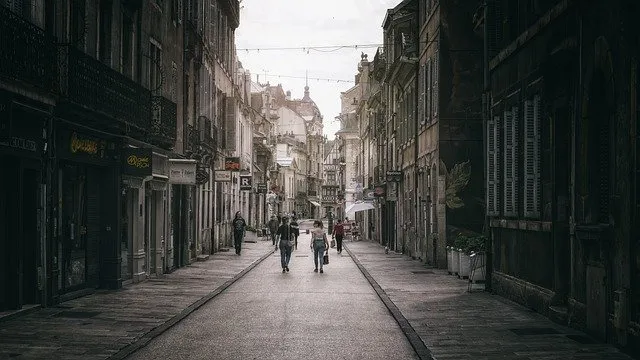
When I talk about shots that have a soul, I mean photos that convey sensations, distinguishing them from the typical "capture a memory" shots. But not only from an aesthetic point of view that we have already mentioned, but as a way of reinforcing elements or playing with contrasts and light, textures… You want the image to make people ask questions. In many occasions, a good photo offers viewers more questions than answers, which gives a certain depth to our work. I advise you to try to frame with backgrounds that are as clean as possible, empty, with no elements that could distract attention from the protagonist of the photo… Whether you want a light or dark background depends on the idea you want to give. To this end, we also have the ability to create silhouettes against the light and create other similar effects in our photos.
But this is just a rule that I use and that suits my style. Other photographers are looking for exactly the opposite, what we could easily call a "chaotic background".
It's your choice to create one sensation or another, but always pay attention to what the background looks like in creating a good shot.
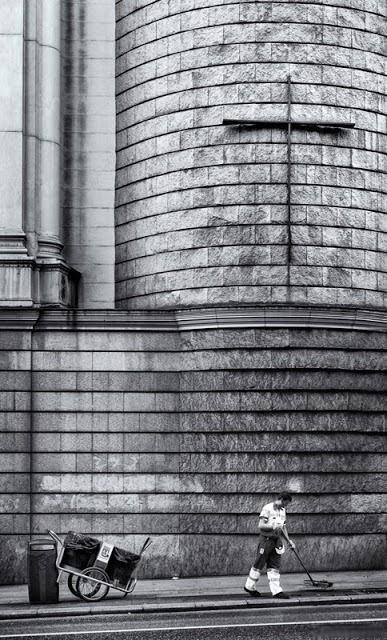
The second point in reference to street photography is related to the importance of the odd number in the composition.
The odd number
It's important to remember that composition rules aren't so much something you're looking for, but rather a way to explain and understand why a photograph works. Unlike what happens in landscape photography, in street photography we will only have a few seconds to compose and capture a scene, which is why it is essential to give due consideration to these rules that I consider important. They are a tool of understanding that we must prioritize when we go out on a photo walk.
I am of the opinion that you can assimilate the composition rules automatically if you spend some time looking at the photos that work thanks to the use of these rules. If you do, you will instinctively start looking for the same compositions in your photos as well.
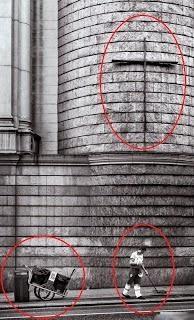
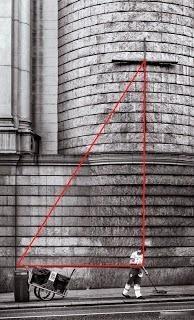
The odd number rule is common to all genres of photography. The odd number, especially the number three, is magical in the photographic world. The presence of three main elements in a shot or a balance of light in irregular successions give rhythm and greater force to a photograph.
Compositely, photographs that highlight three main elements or at least one or more odd elements have much more impact and visual depth.
It is a landscaping rule that is fundamental and reflects our mind's tendency to find geometric figures that facilitate the digestion of a shot. The simplest is the triangle, which needs three elements to take shape. As I like to explain it, our mind is lazy and always tries to simplify everything.
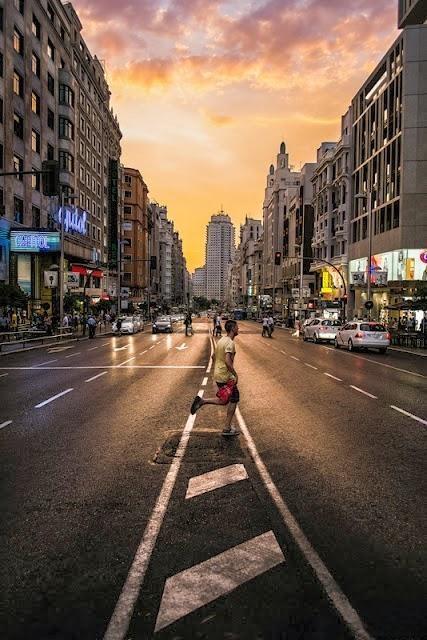
Continuing with the rules of composition applied in street photography, I will now look at a resource that will help us add a dynamic touch and depth to our shots. This resource is nothing more than exploiting the lines present in the scene to create the aforementioned dynamism and depth.
Take advantage of the lines
Logically, these lines can appear obvious, like road markings, or they can appear implied, like a shape created by a contrast of light or the outline of a building.
Working with diagonal lines is simple and only a few photos we take will have these vanishing point guides and give so much depth to our shots.
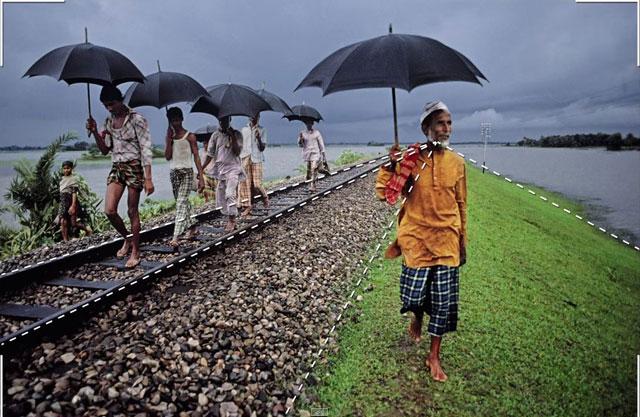 a shot by Steve McCurry
a shot by Steve McCurry
That said, there are actually very few vertical and horizontal lines. Working with these will depend on each individual photographer's style but either way lines are a resource that requires a higher level of photographic vision. In fact, it is one of the most difficult resources to use.
As a quick side note, the use of vertical lines will speed up the viewer's visual path, i.e., if misused, they will cause the viewer to "walk out" of the photo. This is the worst thing that can happen to a photographer: that his image lasts only two seconds in the eyes of the viewer. On the other hand, horizontal lines are an obstacle to the natural line of sight, making them particularly delicate in photography. The combination and balance between the lines is hard to capture, but if you can achieve it the results are truly exceptional. This also applies to street photography.
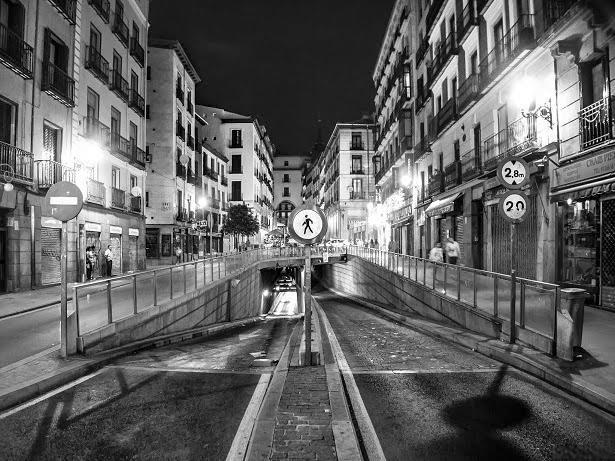
As I've already pointed out, the rules of composition I list here are generally applicable in street photography. now, we're going to talk about rhythm.
Rhythm in photos
Again I insist that the rules of composition in this kind of shots are relative because of the characteristics of street photography: the immediacy and speed needed to capture that unique moment. This is why we shouldn't treat them in the same way as landscape photography, where we try to play with the rules of composition to follow or break them.
In this article, we go over the rules of composition , adapting them to the nature of street photography, so that - once we know them - they can help us, not so much to consciously apply them when we shoot, but rather to understand why certain photos work . With time and practice, if we understand these concepts we will eventually assimilate and apply them intuitively whenever possible.
The protagonist of this section is a rule that has its clearest exponent in a photographer who developed his career in another genre of photography, landscape photography. We are talking about Ansel Adams, who mastered the photographic rhythm in a majestic way. So why study this rule as a possible useful tool for street photography? Mainly because photography is made up of different but interconnected genres. And in street photography it is important to always be aware of not only the subject or subjects, but also the background.
The combination of these elements can create a rhythm between light and dark, a pattern that, again, exploits the mind's tendency to "vague" or simplify. Since the concept is a bit complicated to explain, the next image shows how to establish the rhythm between light and shadow.
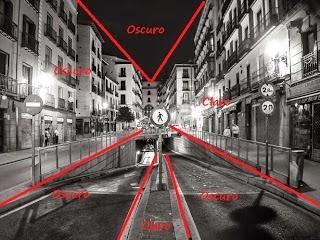
I think the photo is perfect to illustrate this concept. In it we see how the succession between light and dark is regular. I recommend looking at Adams' photographs, which master this concept perfectly. The simplicity of his photography will help us identify these patterns before we start analyzing them in street photography images.
In any case, remember that these rules are more about understanding why a photograph works, so you can have them as a reference for later. As happens in landscape photography, only the experience and instinct you develop will make you instinctively "search" for them over time. We must never forget that the magic of street photography is its immediacy.
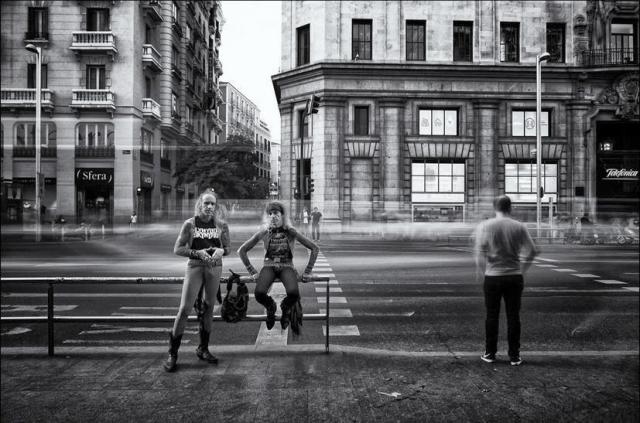 In this case the brothers look into the camera and are the only perfectly defined people
In this case the brothers look into the camera and are the only perfectly defined people
So far, in this article I have talked about a series of rules (how much I dislike this term in photography…) that are not directly related to street photography. Well, in the next section we will talk about it.
Identification of the main subject
First, allow me a couple of considerations.
On the one hand, I repeat again, these rules are not something you should constantly think about when practicing street photography, but rather they are concepts that you can apply and that can improve the final product a bit.
On the other hand, some photographers have a style where there is no main subject or group of subjects in their images. This is the case, for example, of Alex Webb. The images of this MAGNUM photographer are characterized by their chaos, in which the presence of a multitude of scenes within a shot fills, on many occasions, the total area of the frame. Personally, this is not my favorite style of photography, but everyone has their own preferences and tastes.
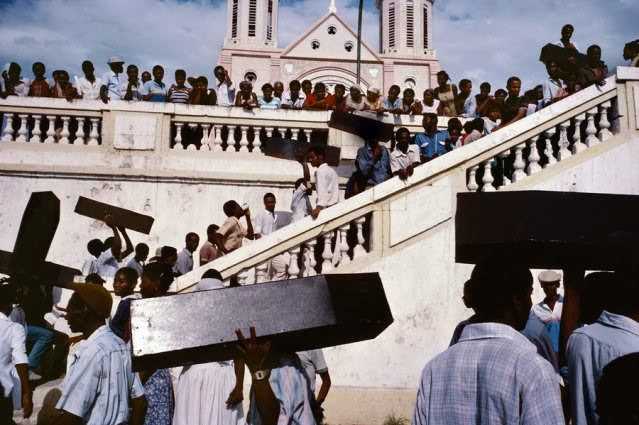 © Alex Webb
© Alex WebbAnd after this premise, let's get to the point...
Identifying the main subject can be done in many ways. It is evident that the maximum expression of the identity of the main subject is the PHOTO ID. A plain, colorless background and the "boy" centered looking at the camera... but of course, if you're reading this article, it's a fact that you want your photos to be more than just a normal passport photo. So let's see how we can give our images a real protagonist.
To do this, there are several techniques that we can apply to individuals or groups in photos. The basic techniques are as follows:
Isolate the subject from the background.
This will give importance to the subject in the frame. If there is only one subject, then there will be no doubts from the people who appreciate (or suffer ;) ) our photographs as to who is the center of attention in the image. You can achieve this with the well-known blurring by using apertures correctly or if the subject is positioned in such a way as to create a very clear contrast to the background or the overall scene. This can be achieved, for example, if the subject is substantially brighter than the rest of the elements in the scene (in which case a good flash can work wonders), or because the tone or temperature of the subject is very different. The latter cases are partly concepts related to the next concept.
Break the pattern.
If one element breaks the "rhythm" or system to which the other elements conform, it will become the main subject. Imagine a row of seats in a football stadium. It is full of fans, all dressed in their team colour, let's say blue. If among them there was a fan of the opposing team, dressed in red, that would be the main subject of the image. Word of advice, if you ever see just one opposing fan in a sea of home team fans, you'd better get a quick picture of them .
Make viewers feel like they're participating in the photo.
You can achieve this by having your subject look at the camera. This makes the shot open, as the gaze will immerse the viewer in the shot and make them participate. The connection that is established between the subject and the viewer is what makes us understand who is the protagonist of the shot.
Granted, if one or more of these elements are present in a person in your shot, it's still not a 100% guarantee that the person will be the "main subject" of the image, but it gives them quite a few upvotes. As always, photography has an element beyond talent and you can't really teach it, only practice can develop it.
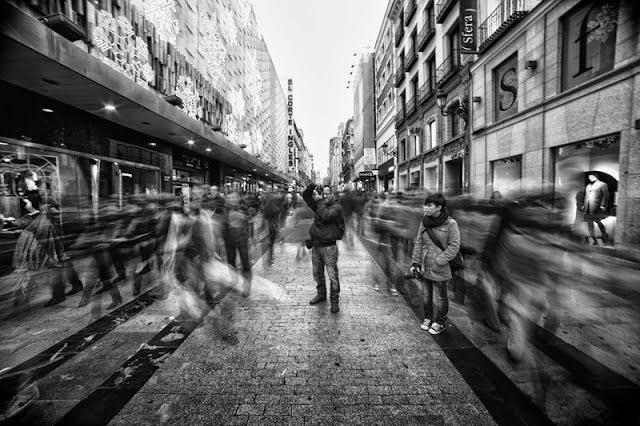
The next rule that we will consider for composition in street photography is closely related to one of the fundamental parameters of photography - the shutter speed.
Traditionally, people try to freeze motion as much as possible in street photography. For example, one iconic image represents the moment just before a man breaks the quiet surface of a puddle. As you probably already suspect, we are talking about one of Henri Cartier Bresson's famous photos.
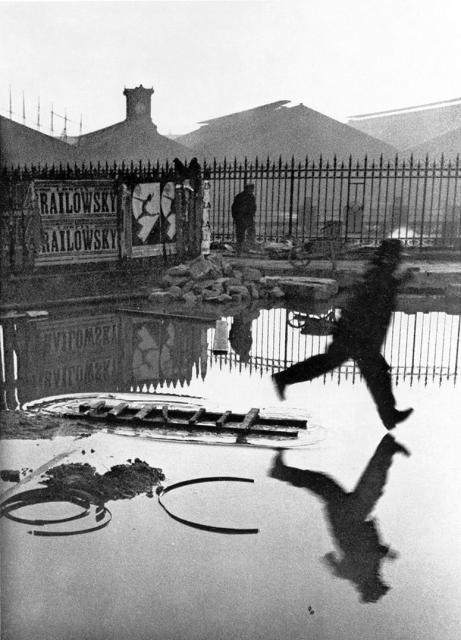
Take advantage of the movement
Taking advantage of movement to tell a story or to give life to a protagonist or the elements that interest us.
Besides allowing us to freeze the movement of a subject, we can work the movement in another way.
For example, we can create ideal environments if the exposure is long enough. In the following photo, the only static elements are the buildings on the street and the two brothers.

In this image, however, the main subject appears disfigured due to movement. In this case, the exhibition resource is used to create contrast between the beggar who is carrying his belongings on a cart in front of the fully defined people who are entering the luxury hotel. This reflects the situation of people who find themselves socially excluded and may even lose their identity in an established system which ignores these people to a large extent.
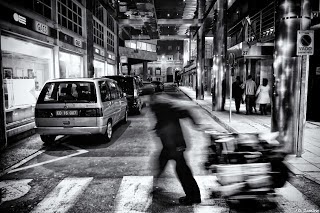
As a theoretical reference, I share some tricks that all photographers should use :
- Shutter speed for freezing objects is usually said to be 1/125 sec, but this is quite relative depending on direction, proximity, etc...
- To photograph in an oblique movement towards the target, the shutter speed should be at least 1/250 sec and 1/500 sec if the movement is perpendicular.
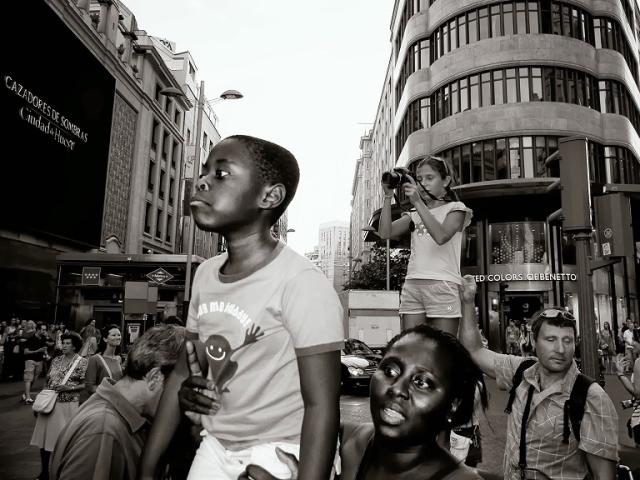
Now, I'm going to talk about a concept that – even if it doesn't form a strictly compositional rule – can translate into a series of guidelines to apply when it comes time to compose.
This concept, like others we've covered in this article, is common to many genres of photography.
It is said that a good photograph is one that tells a story, and many add (myself included) that photos that make viewers ask questions are also good photos. This principle, translated into street photography, means that we need to sharpen our momentum of composition.
A good tip is to try to include a motivating element in the frame, leaving out the story. For example, in the photo that opens this section, we don't know why there is expectation written on the faces of the people in the shot. However, the tension and emotion that “something” arouses is evident in the faces of the adults and in the fact that the children climbed as far as they could to satisfy their curiosity.
Perhaps the simplest form of provoking a viewer's search for answers is to take a close-up of someone's face, a closed portrait that makes a person ask, "what's the story of that boy?" This is a common practice in street photography . The same goes for "stolen" images and "navel" photography, as one of my photographer friends calls it.
In addition to the expressions and emotions that subjects can reflect, we can play with the guiding elements of photography to avoid "the obvious", which means providing clues, but not showing what the source of the story is being told. In this case, we should use the composition rules that we have already seen in the previous sections to achieve the desired effect.
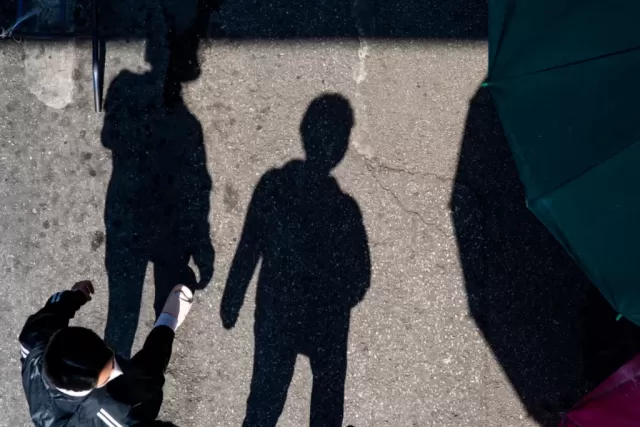
Depriving the main subject of his identity is another way to ask questions. In this case, the resource is used to reflect on how an excluded person loses their identity to much of society when they are "outside the system".
That is, if you want to play with this guideline in composition, you should subtly leave clues for your viewer and avoid a direct presentation of the story. Inevitably in this case, we have to work much harder on our photos and shy away from practices that focus on images stolen from a person a meter away from us. Instead, we need to decide which story to tell and how to make the viewer work to discover it.
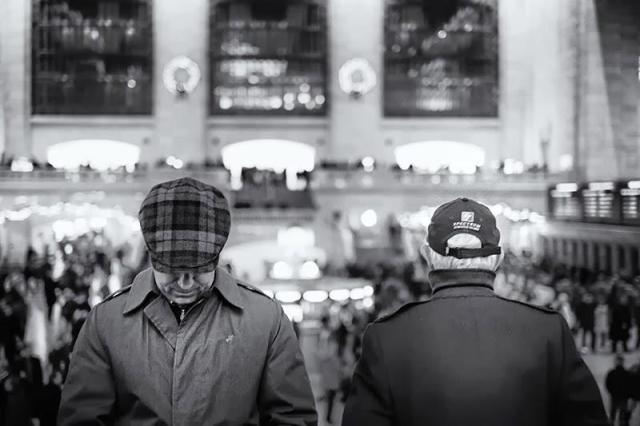
And it's because in general (as with the rules of composition in landscape photography), there should be a certain rhythm and tonal balance, a pattern that makes it easy for the mind to interpret the photo, one that makes the photo "work".
In this case you have to try to break the pattern, alter the cadence, introduce an element clearly different from the rest of those that appear in the shot.
This "alteration" of the motif can be done by focusing on the shape, position, color or emotion that the subjects or elements in the photo convey.
When there are many subjects in an image, capturing this break in the pattern can be tremendously difficult or even the opposite. Again, we must be patient, as we will have to manage to capture a photo that conveys this guideline and at the same time breaks it with one of its elements.
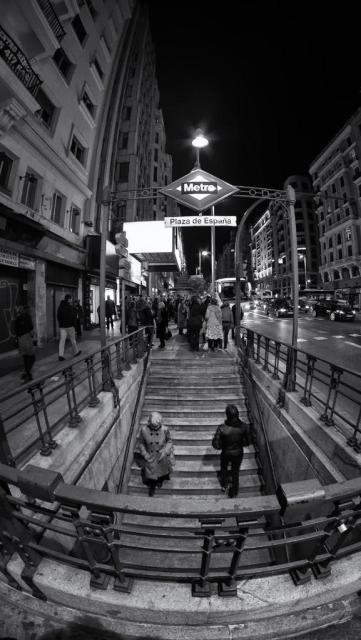
A variant of this composite concept is that of "confronting", to put it with a name, two subjects. In this way, the contrast between the two establishes a composite rhythm in the shot. It is important that if you are using this composite technique, the two subjects in the face-off have characteristics that put them in front of each other very clearly.
This is important since all the weight of the photo will fall on the "fight", be it of color, shape, expression, position… which is why we cannot prevail on this image if the contrast between the two protagonists is not evident and very sharp. For once, we are "radical" in photography.
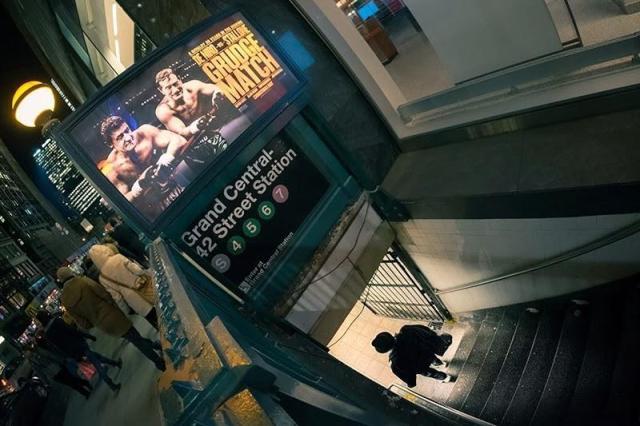
In continuing my exposition of the rules of composition in street photography, let's address the one based on color theory.
But, before we get into this rule, we should ask ourselves what is achieved by shooting in black and white. This is mainly because street photography is usually dominated by black and white images, that's why we should at least mention what are the apparent reasons for suppressing color in our images.
The best way to answer a question is to try to simplify it, to bring it back to its essence. What do we get when we photograph in black and white? The elimination of color.
That is, we eliminate an element of nature. What does it imply? (That would be the second question we could ask ourselves). Well, I think it goes without saying that we make it easier for a photo to work.
Beyond personal taste and mere aesthetics (which is fundamental), when we eliminate color, the protagonists of the image become shapes and textures. Furthermore, from the point of view of creating the image, we leave one element to the free will of the viewer, the “assignment” of the color of each subject gives the photo assimilation. And this is because, in the mind of the observer of the black and white image, colors are instinctively produced to assimilate the image. This is because in the real world there are colors and, like the animals we are, we need to process information in a way that our brains understand. This is one of the reasons why we are all attracted to black and white photography, because in reality everyone "completes" the photo as they want.
Well, now that we know why a color street photograph is harder to capture satisfactorily (since the closer the image is to "reality", the easier it is to fall into the everyday street scenes we all see often if not always) , we must therefore try to play with the resources we have.
This includes using colors (in their different shades) that complement each other, so as to give the shot more visual appeal. Of course, in a genre like street photography, where we're not exactly in a controlled environment, successfully combining colors and making the captured scene attractive is a bit tricky… but that doesn't mean it's impossible.
When you subscribe to the blog, we will send you an e-mail when there are new updates on the site so you wouldn't miss them.
By accepting you will be accessing a service provided by a third-party external to https://www.insightadv.it/


































































Comments